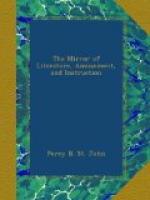The fact was, Andy had met one of the knee-buttons sewed into a piece of the tripe, and it was impossible for him to fail discovering the cheat. The rage, however, was not confined to Andy. As soon as it was understood what had been done, there was an universal rush for Paddy and Jillen; but Paddy was much too cunning to be caught, after the narrow escape he had of it before. The moment after the discovery of the lining, that he could do so without suspicion, he stole from the table, left the house, and hid himself. Jillen did the same; and nothing remained for the eaters, to vent their rage, but breaking every thing in the cabin; which was done in the utmost fury. Andy, however, continued watching for Paddy with a gun, a whole month after. He might be seen prowling along the ditches near the shebeen-house, waiting for a shot at him. Not that he would have scrupled to enter it, were he likely to find Paddy there; but the latter was completely on the shuchraun, and never visited his cabin except by stealth. It was in one of those visits that Andy hoped to catch him.
—Tait’s Edinburgh Magazine.
* * * * *
CONVERSATIONS WITH LORD BYRON.
By the Countess of Blessington.
One of our first rides with Lord Byron was to Nervi, a village on the sea-coast, most romantically situated, and each turn of the road presenting various and beautiful prospects. They were all familiar to him, and he failed not to point them out, but in very sober terms, never allowing any thing like enthusiasm in his expressions, though many of the views might have excited it.
His appearance on horseback was not advantageous, and he seemed aware of it, for he made many excuses for his dress and equestrian appointments. His horse was literally covered with various trappings, in the way of cavesons, martingales, and Heaven knows how many other (to me) unknown inventions. The saddle was a la Hussarde with holsters, in which he always carried pistols. His dress consisted of a nankeen jacket and trousers, which appeared to have shrunk from washing; the jacket embroidered in the same colour, and with three rows of buttons; the waist very short, the back very narrow, and the sleeves set in as they used to be ten or fifteen years before; a black stock, very narrow; a dark-blue velvet cap with a shade, and a very rich gold band and large gold tassel at the crown; nankeen gaiters, and a pair of blue spectacles, completed his costume, which was any thing but becoming. This was his general dress of a morning for riding, but I have seen it changed for a green tartan plaid jacket. He did not ride well, which surprised us, as, from the frequent allusions to horsemanship in his works, we expected to find him almost a Nimrod, It was evident that he had pretensions on this point, though he certainly was what I should call a timid rider. When his




